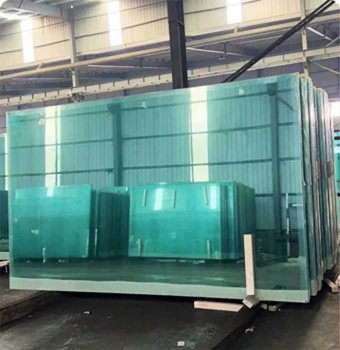Different Types of Architectural Glass
Architectural glass plays a crucial role in modern design and construction, serving not just an aesthetic purpose but also practical functions related to safety, energy efficiency, and comfort. With advancements in technology and engineering, there is a multitude of glass types available, each designed to meet specific needs in architectural projects. Below, we explore various types of architectural glass and their unique characteristics.
1. Annealed Glass
Annealed glass is the most basic type of glass used in architecture. It is produced through a slow cooling process that helps to relieve internal stresses. Suitable for a variety of applications, annealed glass is often utilized in windows and interior partitions. However, its vulnerability to breakage and lack of safety features limit its use in more demanding environments.
2. Tempered Glass
Tempered glass undergoes a process of extreme heating followed by rapid cooling, which significantly increases its strength and thermal resistance. This type of glass is used where safety is paramount, such as in shower doors, facades, and glass railings. When shattered, tempered glass breaks into small, blunt pieces, minimizing the risk of injury. Its durability makes it ideal for both residential and commercial settings.
3. Laminated Glass
Laminated glass consists of multiple layers of glass sandwiched with an interlayer, typically made from PVB (polyvinyl butyral). This construction offers enhanced safety, as the interlayer holds the glass together even if it breaks. Laminated glass effectively reduces noise and UV exposure, making it a great choice for busy urban environments and buildings requiring sound insulation. It is frequently used in skylights, storefronts, and sound barriers.
4. Insulated Glass
different types of architectural glass
Insulated glass units (IGUs) are composed of two or more glass panes separated by a spacer and hermetically sealed to create an airspace. This structure improves thermal performance and energy efficiency by reducing heat transfer. IGUs are crucial in modern building designs, particularly in climates where energy conservation is essential. They help maintain comfortable indoor temperatures and decrease energy costs, making them indispensable for residential and commercial buildings alike.
5. Low-Emissivity (Low-E) Glass
Low-E glass is coated with a thin metallic layer that reflects heat back to its source while allowing light to pass through. This innovative technology enhances energy efficiency, making it popular in both residential and commercial construction. Low-E glass helps to reduce heating and cooling costs and minimizes glare, providing a comfortable indoor environment while maintaining an aesthetically pleasing appearance.
6. Reflective Glass
Reflective glass features a metallic coating that gives it a mirror-like appearance, reflecting sunlight and reducing heat gain. It is commonly used in commercial buildings to create a sleek, modern look while also improving energy efficiency. Reflective glass can reduce glare and enhance privacy without sacrificing natural light, making it ideal for high-rise structures.
7. Smart Glass
Smart glass, or switchable glass, enables users to control the amount of light and heat that passes through. This innovative material can change its transparency through various technologies, such as electrochromic, thermochromic, or photochromic methods. Smart glass allows architects to create dynamic environments that adapt to changing daylight conditions, ultimately enhancing comfort and energy stewardship in buildings.
Conclusion
The choice of architectural glass can profoundly affect a building's aesthetics, energy performance, and occupant comfort. As technology continues to evolve, the range of glass options expands, providing architects and builders with versatile materials to enhance their designs. Understanding the different types of architectural glass available enables stakeholders to make informed decisions, ensuring that both the functional and aesthetic needs of a structure are met.
 Afrikaans
Afrikaans  Albanian
Albanian  Amharic
Amharic  Arabic
Arabic  Armenian
Armenian  Azerbaijani
Azerbaijani  Basque
Basque  Belarusian
Belarusian  Bengali
Bengali  Bosnian
Bosnian  Bulgarian
Bulgarian  Catalan
Catalan  Cebuano
Cebuano  Corsican
Corsican  Croatian
Croatian  Czech
Czech  Danish
Danish  Dutch
Dutch  English
English  Esperanto
Esperanto  Estonian
Estonian  Finnish
Finnish  French
French  Frisian
Frisian  Galician
Galician  Georgian
Georgian  German
German  Greek
Greek  Gujarati
Gujarati  Haitian Creole
Haitian Creole  hausa
hausa  hawaiian
hawaiian  Hebrew
Hebrew  Hindi
Hindi  Miao
Miao  Hungarian
Hungarian  Icelandic
Icelandic  igbo
igbo  Indonesian
Indonesian  irish
irish  Italian
Italian  Japanese
Japanese  Javanese
Javanese  Kannada
Kannada  kazakh
kazakh  Khmer
Khmer  Rwandese
Rwandese  Korean
Korean  Kurdish
Kurdish  Kyrgyz
Kyrgyz  Lao
Lao  Latin
Latin  Latvian
Latvian  Lithuanian
Lithuanian  Luxembourgish
Luxembourgish  Macedonian
Macedonian  Malgashi
Malgashi  Malay
Malay  Malayalam
Malayalam  Maltese
Maltese  Maori
Maori  Marathi
Marathi  Mongolian
Mongolian  Myanmar
Myanmar  Nepali
Nepali  Norwegian
Norwegian  Norwegian
Norwegian  Occitan
Occitan  Pashto
Pashto  Persian
Persian  Polish
Polish  Portuguese
Portuguese  Punjabi
Punjabi  Romanian
Romanian  Russian
Russian  Samoan
Samoan  Scottish Gaelic
Scottish Gaelic  Serbian
Serbian  Sesotho
Sesotho  Shona
Shona  Sindhi
Sindhi  Sinhala
Sinhala  Slovak
Slovak  Slovenian
Slovenian  Somali
Somali  Spanish
Spanish  Sundanese
Sundanese  Swahili
Swahili  Swedish
Swedish  Tagalog
Tagalog  Tajik
Tajik  Tamil
Tamil  Tatar
Tatar  Telugu
Telugu  Thai
Thai  Turkish
Turkish  Turkmen
Turkmen  Ukrainian
Ukrainian  Urdu
Urdu  Uighur
Uighur  Uzbek
Uzbek  Vietnamese
Vietnamese  Welsh
Welsh  Bantu
Bantu  Yiddish
Yiddish  Yoruba
Yoruba  Zulu
Zulu 

